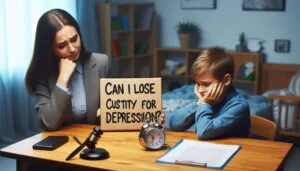Short-Term Disability for Anxiety and Depression: What You Should Know
- Published -
- Reading Time: 6 minutes
-
Written by - Rajat N
- Reviewed by - Dr. Josh Johnson

“Anxiety problems limit the ability of over forty million adults in America every year.” Unfortunately, so many people have such issues, that looking for help is often the hardest part, and seeking it becomes even more difficult with work adding pressure on an already strained situation. If you ever thought about whether anxiety and depression are short-term disability (STD) qualifying factors or not, this article will help you understand as I will explain what short-term disability is, how it relates to mental health, and how to conquer the system confidently.
source – https://www.youtube.com/watch?v=fRE-T4lPsfQ
Note: The video content is intended to provide supplementary information and a different perspective on the discussed topic. All information and advice presented in this article are based on expert guidance and review.
Understanding Short-Term Disability Use and Its Processes
Short-term disability income insurance pays income benefits when you are unable to work due to a medical condition. When one considers a physical injury, that in almost every case will come first. But the same negative thinking can be caused by mental health issues, for example, anxiety or even depression.
Characteristics Of Short-Term Disability:
- Covers 40 to 70 percent of a user’s income but can last as long as six months.
- Medical proof of work incapacity is required paperwork.
- Available through an employer group policy as an individual purchase or as part of a comprehensive insurance policy.
Professional Tip: If you feel that your mental health might affect your capacity to work, it would be in your best interest to check your employer’s disability policy and discuss this issue with HR.
Why Undiagnosed Anxiety and Depression is a Problem
Most of us suffer mental health issues without being aware of it. Unlike an arm fracture or a surgical procedure, anxiety-related disorders depression don’t scream for attention. To some people, this becomes a problem when trying to justify taking time off work.
Typical Stresses Include:
Stigma: The fear of being branded as ‘weak’ or ‘unprofessional’ by one’s superiors.
Self-Doubt: You may find yourself debating whether your particular condition is “bad enough” to require a break.
Lack of Awareness: Employees and employers alike often do not realize that mental health conditions are included in the mental health STD policies.
Case Study: Sarah, a short-term disability graphic designer, suffered from significant anxiety disorder. For months she continued to work while being in constant state of panic until panic attacks became unbearable. With her doctor’s assistance, she managed to get approved for short-term disability and used that time away from work to recuperate.
Signs That Warrant Taking Leave
Understanding that it’s okay to take a cut is important self-care. Anxiety and depression show up in various forms. Common signs one should watch out for include:
Physical Symptoms: Overtiredness, constant fatigue, persistent aching headaches, stomach problems, and insomnia along with a sense of paranoia and feeling overwhelmed.
Issues with Performance: Challenges in concentrating, letting deadlines pass, or not doing more than needed.
Social Isolation: Stepping back from interacting with colleagues or feeling as if a social barrier exists.
Myth Debunking: “If I take a leave of absence I will lose my job”.
Incorrect! Legislation such as the Family and Medical Leave Act (FMLA) or the Americans with Disabilities Act (ADA) grants you employment protection while being on an approved leave. Make sure you consult your state laws regarding this issue as well.
How to Apply for a Short-Term Disability
Claiming short-term disability benefits can be overwhelming, but it is possible with certain steps:
Consult With Your Physician: They will determine your situation and offer medical evidence as required.
Policy Perusal: Know what is included, waiting times, and proof that needs to be submitted.
HR Department Communication: Inform the employer that you wish to make a claim for STD benefits and obtain necessary paperwork.
Filing the Claim: Attach all relevant documentation and submit the application request.
Follow-up: Be ready for further scrutiny and additional proof if required.
Informed Perspective: Dr. Melissa Carter who is a registered psychologist said, “In your documentation, having comprehensive information like treatment plans, progress notes and even diagnostic assessments bolster your claim.”
How to Manage the Psychological Effects of Time Off Work
Taking a leave has its pros and cons. It can come with a sense of relief, but guilt and uncertainty often accompany it. Here’s how to manage:
Reassess the Reality: Think of leave as a productive step for future well-being instead of a setback.
Keep in Touch: Handover essential updates to a trusted colleague or supervisor so you don’t feel isolated and have an easier time later reintegrating into work.
Get Help: Seek therapy or confide in a reputable friend. It helps create a safe place for your feelings.
Personal Experience: An accountant, John noted how therapy during his leave period helped him become more confident. “When I learned how to set boundaries, I felt more in control upon my return to my workplace.”
Shifts in Emotion and Recovery Phase Expectations
Many anticipate some form of emotional shift what people call recovery but it’s often misunderstood. It’s common for the feeling of ease to be felt on some days while other days may feel worse. Focus on:
Creating a Schedule: Exercise regularly, eat healthy balanced meals, and practice mindfulness.
Tracking Milestones: Celebrate your successes even if they are small. For example, going a day without a panic attack or completing a therapy session.
Setting Boundaries: If it is possible, do not throw yourself into work right away. Gradually increase your workload.
“I’ll be fully healed by the time I return to work,” the motto falls flat.
Recovery is not a linear path; rather, recovery is considered in progress. Going back to work simply means that you are ready to return to work, not that treatment is “done.”
On How Employers Can Aid Mental Health
The workplace is vital to one’s mental health:
- Foster an Accepting Atmosphere: Conversations addressing mental health stigma should be commonplace within the organization.
- Provide Support: Ensure that EAPs, counseling, and wellness programs are accessible to employees.
- Educate Supervisors: Ensure that all management have the capacity to detect and deal with issues of mental ill health.
For instance, a technology firm that adopted 30 percent of attendance within absence driven targets achieved 30 percent lower rates of absence from work by introducing additional measures.
In Closing: Getting Back to Basics
When seeking anxiety or depression-related short-term disability, think of it as self-care rather than surrendering. Take notice of your current feelings. Life requires reflection in order to reach set goals. Take note: doing less now can promote feeling better in the future.
For Action: Request a healthcare appointment if considering short-term disability- it is not as difficult as it is made out to be, so why wait when help is always available?
FAQs
- Am I eligible for short-term disability due to anxiety or depression?
As long as an anxiety or depression condition prevents you from working you can qualify. Ensure you have the proper documentation from a healthcare provider for your claim.
- What kind of documentation is needed when applying?
The following is typically needed: a physician’s statement giving a diagnosis, a treatment plan, and an explanation justifying your incapacity to work due to an illness or injury.
- How many months can I receive short-term disability benefits?
The duration ranges from one month to half a year. The precise period however will be determined by your policy. Check your specific plan for exact timeframes.
- Does short term disability cover the entire duration of the period absence?
Not always. Most policies have a waiting period of almost a week or an elimination period before benefits commence. You may need to burn sick or vacation days during this period.
- While on short-term disability, will I receive my full salary?
No, the majority of short-term disability policies only cover a certain percentage, usually between 40% and 70%.
- How do I start a claim for short-term disability?
The first step is to contact your HR department and get the required forms. After that, your healthcare provider should fill the medical portions of the claim form and submit it following the required processes.
- Is it possible for my employer to refuse my claim for short-term disability?
Yes, there can be a refusal on claims arising out of insufficient supporting documents, the condition not being covered, or even policy violation at the submission of the claim.
- Is there anything I can do when my claim gets refused?
If your claim is denied, you have the right to appeal. You should ensure to read the letter of denial, make note of the relevant facts that need backing and put the appeal within the stipulated timeframe.
- What are the implications of taking short-term disability on my job security?
Employees are covered by the Family and Medical Leave Act (FMLA) which allows 12 weeks of unpaid leave, so it is highly unlikely that taking short-term disability will impact your employment. Be mindful however that not all employers are bound by FMLA rules so you should check your place of employment.
- Is it possible to have a part-time job while on short-term disability?
In general terms, no. As the term suggests, short-term disability is for someone who cannot work. Some policies do offer partial benefits if limited duties can be carried out so check your plan provisions for these details.






